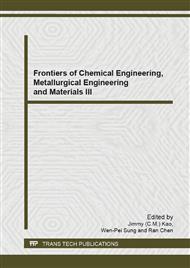[1]
A. E. Frumkin, A. M. Churakov, Y. A. Strelenko, et al. Org. Lett. 1 (1999), 721–724.
Google Scholar
[2]
T. G. Archibald, R. Gilardi, K. Baum, et al. J. Org. Chem. 55 (1990), 2920–2924.
Google Scholar
[3]
M. A. Hiskey, M. M. Stincipher, J. E. Brown. J. Energ. Mater. 11 (1993), 157–165.
Google Scholar
[4]
H. X. Ma, B. Yan, Z. N. Li, et al. J. Hazard. Mater. 169 (2009), 1068–1073.
Google Scholar
[5]
H. X. Ma, B. Yan, J. F. Li, et al. J. Mol. Struct. 981 (2010), 103–110.
Google Scholar
[6]
H. X. Ma, B. Yan, Y. H. Ren, et al. J. Therm. Anal. Calorim. 103 (2011), 569–575.
Google Scholar
[7]
B. Yan, H. X. Ma, N. N. Zhao, et al. J. Therm. Anal. Calorim. 110 (2012), 1253–1257.
Google Scholar
[8]
B. Yan, N. N. Zhao, T. Mai, et al. Russ. J. Phys. Chemi. A. 86 (2012), 1962–(1968).
Google Scholar
[9]
B. Yan, H. Y. Li, N. N. Zhao, et al. Acta Cryst. E 68(2012), o3376.
Google Scholar
[10]
B. Yan, N. N. Zhao, H. X. Ma, et al. S. Afr. J. Chem. 66 (2013), 136–139.
Google Scholar
[11]
B. Yan, H. Y. Li, N. N. Zhao, et al. J. Chem. Eng. Data. 58 (2013), 3033–3038.
Google Scholar
[12]
B. Yan, H. Y. Li, N. N. Zhao, et al. J. Chem. Thermodynamics. 69 (2014), 152–156.
Google Scholar
[13]
G. te Velde, F. M. Bickelhaupt, E. J. Baerends, et al. J. Comput. Chem. 22 (2001), 931–967.
Google Scholar
[14]
C. Fonseca Guerra, J.G. Snijders, G. te Velde, et al. Theor. Chem. Acc. 99 (1998), 391–403.
DOI: 10.1007/s002140050021
Google Scholar
[15]
E. J. Baerends, J. Autschbach, A. Bérces, et al. ADF2005. 01, SCM, Vrije Universiteit, The Netherlands, (2005).
Google Scholar
[16]
H.X. Chen, S.S. Chen, L.J. Li, et al. J. Hazard. Mater. 175 (2010), 569–574.
Google Scholar
[17]
S. H. Vosko, L. Wilk, M. Nusair. Can. J. Phys. 58(1980), 1200–1211.
Google Scholar
[18]
C. Adamo, V. Barone. J. Chem. Phys. 108(1998), 664–675.
Google Scholar
[19]
J. P. Perdew, J. A. Chevary, S. H. Vosko, et al. Phys. Rev. B. 46(1992), 6671–6687.
Google Scholar
[20]
I. Mayer. Chem. Phy. Let. 97(1983), 270–274.
Google Scholar
[21]
F. L. Hirshfeld. Theor. Chim. Acta. 44(1977), 129–138.
Google Scholar


